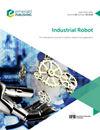基于双信号比较接触检测的软手形状感知
IF 2.5
4区 计算机科学
Q3 ENGINEERING, INDUSTRIAL
Industrial Robot-The International Journal of Robotics Research and Application
Pub Date : 2023-07-04
DOI:10.1108/ir-02-2023-0033
引用次数: 0
摘要
目的在软手抓取任务中充分展示了柔性机器人的结构自适应能力。一只柔软的手可以很容易地实现物体的包络操作,而不需要规划。随着机器人应用的不断发展,研究人员已经不再满足于软手的抓取能力。本文的目的是在抓取的同时感知物体的形状,为更智能的机器人应用提供决策依据。设计/方法/方法本文提出了一种双信号比较方法来获得指尖位置。双信号包括不考虑外载荷变化的静态模型计算的位移和弯曲传感器计算的位移。双信号比较法可以利用上述两种信号在悬停状态和接触状态下的明显变化趋势差来识别触摸位置。作者通过触摸操作使软手在物体周围扫描以检测物体的形状,并且每个触摸指尖位置的轨迹可以包裹物体的形状。实验结果表明,双信号比较方法可以准确识别柔软手指的接触力矩。这种检测方法使柔软的手具有形状检测能力。实验中的软手可以感知正方形、圆形和其他一些复杂的形状。本文提出的双信号比较法可以利用粗糙机器人模型和传感在工作状态突然变化时的信号变化趋势来检测触摸动作,从而提高了测量信号的利用价值。大模型误差和不准确传感器的问题也对其他软机器人的使用产生了负面影响。以刚性机器人分析的思维,直接使用这些模型和传感器,一般难以取得良好的效果。本文的双信号比较方法可以为这方面提供一些参考。本文章由计算机程序翻译,如有差异,请以英文原文为准。
Shape perception of soft hand based on dual-signal comparison contact detection
Purpose
The structural adaptive ability of the soft robot is fully demonstrated in the grasping task of the soft hand. A soft hand can easily realize the envelope operation of the object without planning. With the continuous development of robot applications, researchers are no longer satisfied with the ability of the soft hand to grasp. The purpose of this paper is to perceive the object’s shape while grasping to provide a decision-making basis for more intelligent robot applications.
Design/methodology/approach
This paper proposes a dual-signal comparison method to obtain the fingertip position. The dual signal includes the displacement calculated by the static model without considering the external load change and the displacement calculated by the bending sensor. The dual-signal comparison method can use the obvious change trend difference between the above two signals in the hover and contact states to identify the touch position. The authors make the soft hand scan around the object through touch operation to detect the object’s shape, and the tracks of every touch fingertip position can envelop the object’s shape.
Findings
The experimental results show that the dual-signal comparison method can accurately identify the contact moment of soft fingers. This detection method makes the soft hand develop the shape detection ability. The soft hand in the experiment can perceive squares, circles and a few other complex shapes.
Originality/value
The dual-signal comparison method proposed in this paper can detect a touch action by using the signal change trend when the working condition suddenly changes with the rough robotic model and sensing, thus improving the utilization value of the measured signal. The problems of large model errors and inaccurate sensors also negatively impact the use of other soft robots. It is generally difficult to achieve good results by directly using these models and sensors with the thinking of rigid robot analysis. The dual-signal comparison method in this paper can provide some reference for this aspect.
求助全文
通过发布文献求助,成功后即可免费获取论文全文。
去求助
来源期刊
CiteScore
4.50
自引率
16.70%
发文量
86
审稿时长
5.7 months
期刊介绍:
Industrial Robot publishes peer reviewed research articles, technology reviews and specially commissioned case studies. Each issue includes high quality content covering all aspects of robotic technology, and reflecting the most interesting and strategically important research and development activities from around the world.
The journal’s policy of not publishing work that has only been tested in simulation means that only the very best and most practical research articles are included. This ensures that the material that is published has real relevance and value for commercial manufacturing and research organizations. Industrial Robot''s coverage includes, but is not restricted to:
Automatic assembly
Flexible manufacturing
Programming optimisation
Simulation and offline programming
Service robots
Autonomous robots
Swarm intelligence
Humanoid robots
Prosthetics and exoskeletons
Machine intelligence
Military robots
Underwater and aerial robots
Cooperative robots
Flexible grippers and tactile sensing
Robot vision
Teleoperation
Mobile robots
Search and rescue robots
Robot welding
Collision avoidance
Robotic machining
Surgical robots
Call for Papers 2020
AI for Autonomous Unmanned Systems
Agricultural Robot
Brain-Computer Interfaces for Human-Robot Interaction
Cooperative Robots
Robots for Environmental Monitoring
Rehabilitation Robots
Wearable Robotics/Exoskeletons.

 求助内容:
求助内容: 应助结果提醒方式:
应助结果提醒方式:


